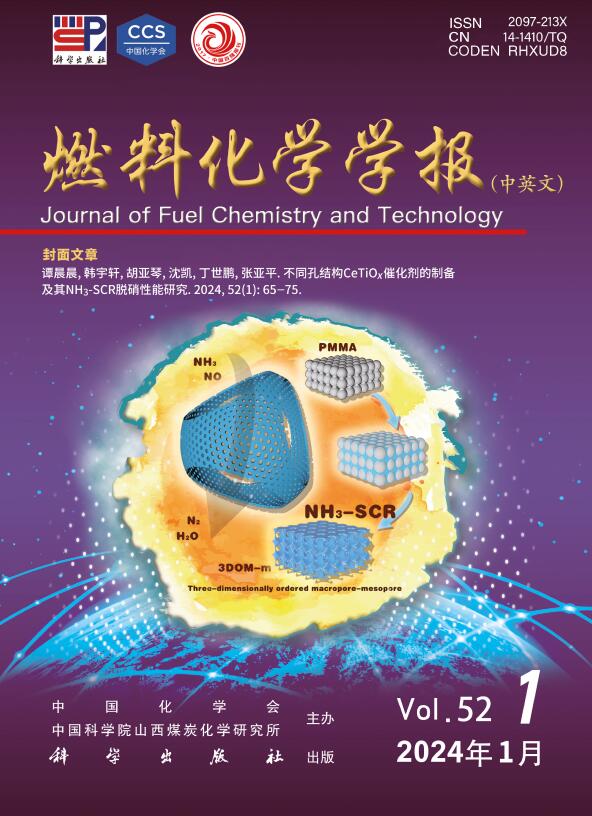Photocatalytic oxidation of toluene to benzaldehyde over exposed hydroxyl ZnTi-LDH nanosheets with O2/CO2
Q3 Energy
引用次数: 0
Abstract
To address the issues of low yield and selectivity of benzaldehyde in the photocatalytic CO2-toluene reactions, a ZnTi-LDH photocatalyst with exposed hydroxyl groups was developed and a novel co-photocatalytic reaction system involving O2/CO2-toluene was established. The structure of ZnTi-LDH catalyst was characterized using XRD, FT-IR, N2 adsorption-desorption isotherms, XPS and other techniques. The effects of catalyst composition and O2/CO2 ratio on the yield and selectivity of benzaldehyde in the O2/CO2 co-photocatalytic oxidation of toluene were investigated in a pressurized reactor. The techniques and instruments such as isotope tracing, radical quenching, GC-MS, EPR, and others were employed to elucidate the free radical mechanism underlying the O2/CO2 synergistic photocatalytic oxidation of toluene. The results indicate that under solvent-free conditions, with a ZnTi-LDH catalyst composition of 3:1 (ZT-3:1) and an O2/CO2 ratio of 2:8, the irradiation by xenon light for 12 h yielded CO and benzaldehyde at rates of 121.37 and 947.89 μmol/(g·h), respectively, with selectivities of 96% and 60%. The total yield was 3.02 times higher than that of the CO2-toluene reaction alone. Selectivities for CO and benzaldehyde increased by 7% and 11%, respectively. These improvements are attributed primarily to the abundant −OH groups and high specific surface area of ZT-3:1, which promote the activation of CO2 adsorption on the catalyst, and the synergistic effect of O2 and CO2 expands the pathways for free radical reactions and improves the carrier utilization efficiency. This study provides a new approach to enhancing the CO2 conversion efficiency and co-producing the high-value-added products.
暴露的羟基ZnTi-LDH纳米片上O2/CO2光催化氧化甲苯制苯甲醛
针对苯甲醛在光催化co2 -甲苯反应中产率低、选择性差的问题,研制了一种羟基暴露的ZnTi-LDH光催化剂,建立了一种新的O2/ co2 -甲苯共光催化反应体系。采用XRD、FT-IR、N2吸附-脱附等温线、XPS等技术对ZnTi-LDH催化剂的结构进行了表征。在加压反应器中研究了O2/CO2共光催化氧化甲苯反应中催化剂组成和O2/CO2比对苯甲醛收率和选择性的影响。采用同位素示踪、自由基猝灭、GC-MS、EPR等技术和仪器对O2/CO2协同光催化氧化甲苯的自由基机理进行了研究。结果表明,在无溶剂条件下,在ZnTi-LDH催化剂配比为3:1 (ZT-3:1)、O2/CO2比为2:8的条件下,氙灯照射12 h, CO和苯甲醛的产率分别为121.37和947.89 μmol/(g·h),选择性分别为96%和60%。总产率是co2 -甲苯单独反应的3.02倍。对CO和苯甲醛的选择性分别提高了7%和11%。这些改善主要是由于丰富的−OH基团和ZT-3:1的高比表面积促进了CO2在催化剂上吸附的活化,O2和CO2的协同作用扩展了自由基反应的途径,提高了载体的利用效率。该研究为提高CO2转化效率和协同生产高附加值产品提供了一条新途径。
本文章由计算机程序翻译,如有差异,请以英文原文为准。
求助全文
约1分钟内获得全文
求助全文
来源期刊

燃料化学学报
Chemical Engineering-Chemical Engineering (all)
CiteScore
2.80
自引率
0.00%
发文量
5825
期刊介绍:
Journal of Fuel Chemistry and Technology (Ranliao Huaxue Xuebao) is a Chinese Academy of Sciences(CAS) journal started in 1956, sponsored by the Chinese Chemical Society and the Institute of Coal Chemistry, Chinese Academy of Sciences(CAS). The journal is published bimonthly by Science Press in China and widely distributed in about 20 countries. Journal of Fuel Chemistry and Technology publishes reports of both basic and applied research in the chemistry and chemical engineering of many energy sources, including that involved in the nature, processing and utilization of coal, petroleum, oil shale, natural gas, biomass and synfuels, as well as related subjects of increasing interest such as C1 chemistry, pollutions control and new catalytic materials. Types of publications include original research articles, short communications, research notes and reviews. Both domestic and international contributors are welcome. Manuscripts written in Chinese or English will be accepted. Additional English titles, abstracts and key words should be included in Chinese manuscripts. All manuscripts are subject to critical review by the editorial committee, which is composed of about 10 foreign and 50 Chinese experts in fuel science. Journal of Fuel Chemistry and Technology has been a source of primary research work in fuel chemistry as a Chinese core scientific periodical.
 求助内容:
求助内容: 应助结果提醒方式:
应助结果提醒方式:


